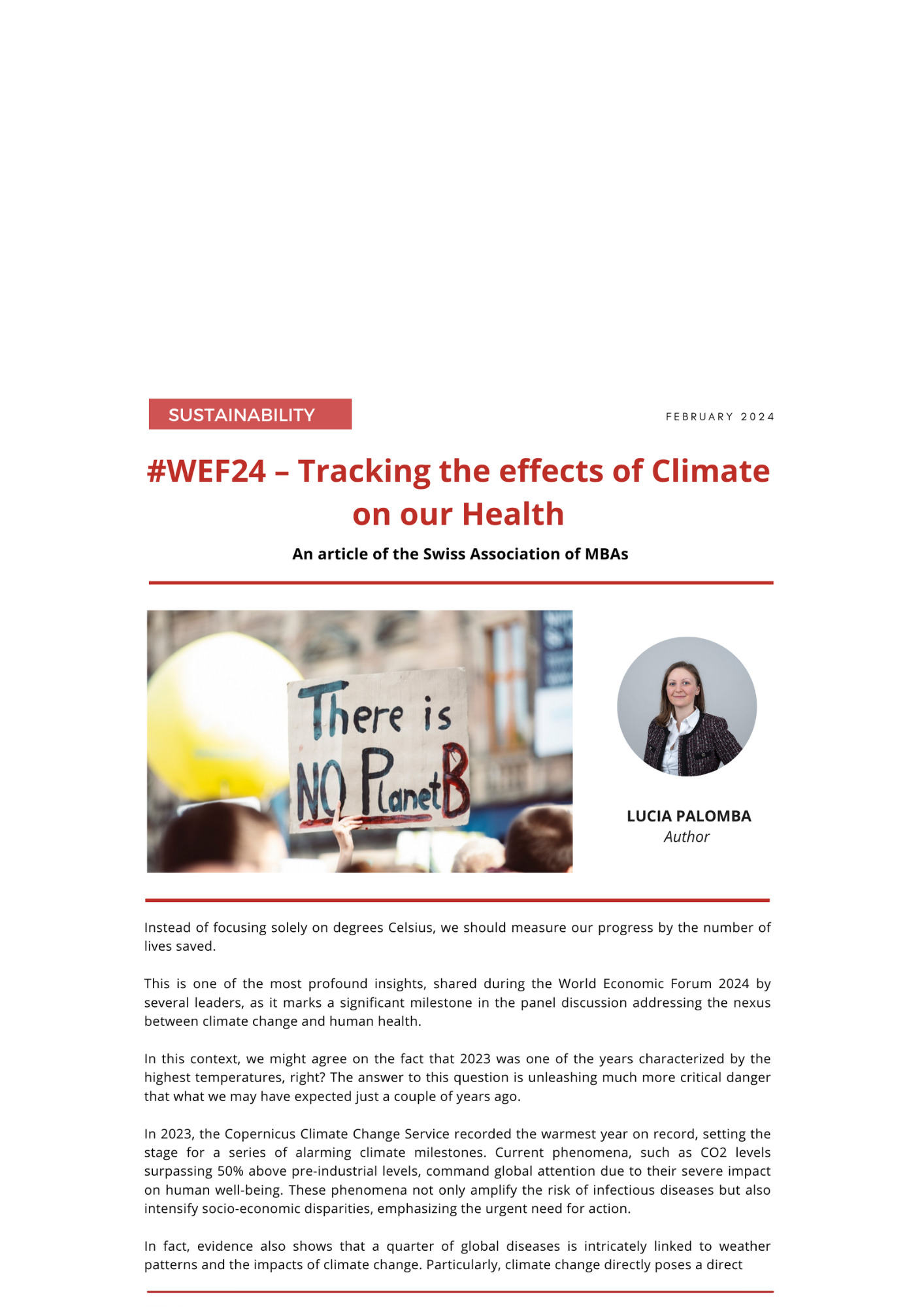
Instead of focusing solely on degrees Celsius, we should measure our progress by the number of lives saved.
This is one of the most profound insights, shared during the World Economic Forum 2024 by several leaders, as it marks a significant milestone in the panel discussion addressing the nexus between climate change and human health.
In this context, we might agree on the fact that 2023 was one of the years characterized by the highest temperatures, right? The answer to this question is unleashing much more critical danger that what we may have expected just a couple of years ago.
In 2023, the Copernicus Climate Change Service recorded the warmest year on record, setting the stage for a series of alarming climate milestones. Current phenomena, such as CO2 levels surpassing 50% above pre-industrial levels, command global attention due to their severe impact on human well-being. These phenomena not only amplify the risk of infectious diseases but also intensify socio-economic disparities, emphasizing the urgent need for action.
In fact, evidence also shows that a quarter of global diseases is intricately linked to weather patterns and the impacts of climate change. Particularly, climate change directly poses a direct threat to health through the proliferation of diseases and mental health challenges, disproportionately affecting communities residing in the most vulnerable regions of the world.
Therefore, recognizing the urgent need for action, 123 nations have signed the COP28 UAE Declaration on Climate and Health. This event indicates governments' acknowledgment of the mounting health crisis induced by climate change and the profound need of substantive climate action such as reductions in air pollution and healthcare costs.
Immediate action is imperative, as also indicated by the WEF Insight report on this theme in collaboration with Oliver Wyman, which estimates an additional 14.5 million deaths and $12.5 trillion in economic losses attributable to climate change impacts by 2050.
Consequently, perspectives from industry on adaptation, healthcare system resilience, and decarbonization are indispensable components of this effort, especially because the traditional metrics in use like global surface temperatures and atmospheric carbon dioxide levels fail to capture the human dimension of climate change, which would be fundamental for developing a global call for action.
As we know, it is not a mystery that natural disasters such as inundations, droughts, heatwaves, tropical storms, wildfires, and sea-level rise are no longer distant threats—they are already upon us. These events, underscored by the Intergovernmental Panel on Climate Change, profoundly impact health determinants and socio-economic well-being, and need targeted solutions informed by comprehensive data analysis.
Going into detail, close repercussions include effects such as malnutrition, respiratory and cardiovascular disorders, or increased exposure to infectious diseases, while longer-term consequences may notice impaired child development due to malnutrition, respiratory ailments, or mental health disorders deriving from traumas.
The analysis presented in the World Economic Forum report has the aim to explain the deepest causes of these catastrophes and trace the workable solutions by looking at the future projections of these effects. The key insights origin from the study of diverse sources such as the World Health Organization (WHO) framework for climate change, the IPCC (Intergovernmental Panel on Climate Change), other UN-sponsored agencies, the World Meteorological Organization (WMO) and several scientific research sources.
Particularly, the IPCC highlights a strong human health risk detected in terms of days per year of exposure of the global population to hypothermic conditions leading to mortality risk caused by certain levels of surface air temperature and humidity for the historical period 1991 -2005 and a global warming level of 1.7°C–2.3°C (average = 1.9°C; 13 climate models) on the picture below, left side, 2.4°C– 3.1°C (average = 2,7°C; 16 climate models) in the middle and 4.2°C–5.4°C (average = 4.7°C; 15 climate models) on the right.
Additionally, it has been shown that 3.3-3.6 billion people live in contexts that present a high rate of vulnerability to climate change. Over the last 15 years, and between 2010 and 2020, the level of human mortality due to floods, droughts and storms has been recorded as fifteen times higher in these types of geographical regions, compared to areas with a low level of vulnerability. For example, in the Arctic areas, the changes by which the cryosphere has been affected have been strongly felt by Indigenous populations, as the impacts on human and the ecosystem are strongly interdependent.
All these results make researchers reflect, because the vulnerability of ecosystems and people to different climate changes have reached high levels shaped between regions and within them with different intensities due to causes such as: different socioeconomic models and inequalities, unsustainable use of oceans and land, marginalization.



